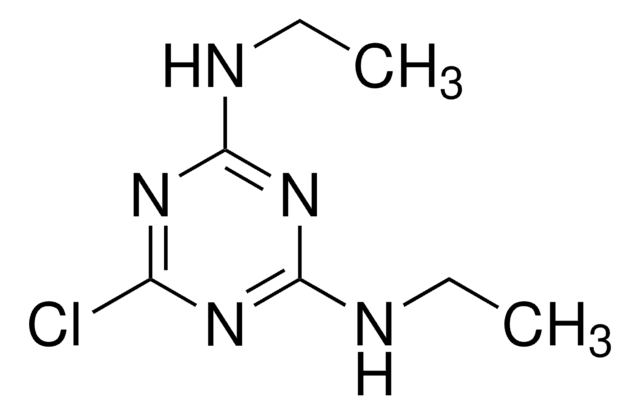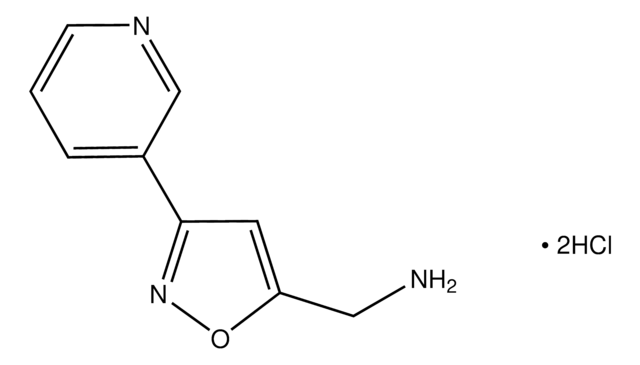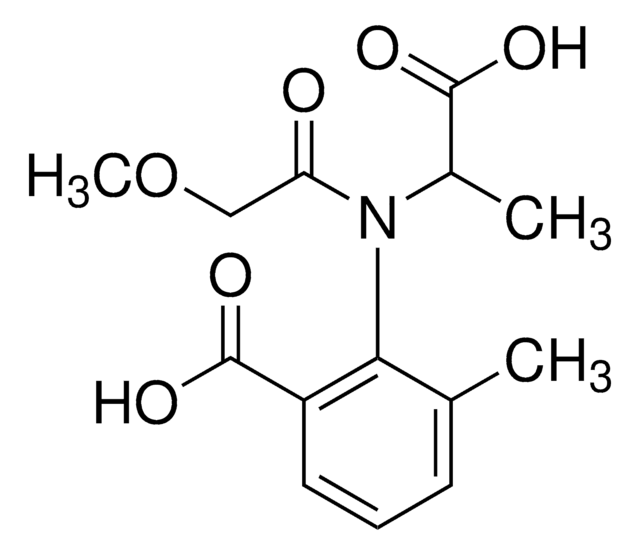CRM72861
Captafol
certified reference material, TraceCERT®, Manufactured by: Sigma-Aldrich Production GmbH, Switzerland
About This Item
Recommended Products
grade
certified reference material
TraceCERT®
Quality Level
product line
TraceCERT®
shelf life
limited shelf life, expiry date on the label
manufacturer/tradename
Manufactured by: Sigma-Aldrich Production GmbH, Switzerland
format
neat
SMILES string
ClC(Cl)C(Cl)(Cl)SN1C(=O)C2CC=CCC2C1=O
InChI
1S/C10H9Cl4NO2S/c11-9(12)10(13,14)18-15-7(16)5-3-1-2-4-6(5)8(15)17/h1-2,5-6,9H,3-4H2
InChI key
JHRWWRDRBPCWTF-UHFFFAOYSA-N
Looking for similar products? Visit Product Comparison Guide
General description
Certified content by quantitative NMR incl. uncertainty and expiry date are given on the certificate.
Download your certificate at: http://www.sigma-aldrich.com
Captafol is a phthalimide fungicide, used for its non-systemic protective and curative benefits on various fruits and vegetables such as pome fruit, stone fruit, potatoes, carrots, apples, tomatoes, beets, cotton, peanuts, and rice.
As per Regulation (EC) No. 1107/2009, repealing directive 91/414/EEC, captafol is not approved for use in the European Union as a plant protection product. But maximum residue levels of 0.02 mg/kg and 0.05 mg/kg are allowed for its presence in frozen/fresh fruits and tree nuts respectively according to the EU Reg. No 899/2012.
Application
Captafol CRM can also be used as follows:
- Development and validation of a method for simultaneous detection and quantification of captan, captafol, folpet, iprodione, and their main metabolites in six samples of fruits and vegetables by liquid chromatography-tandem mass spectrometry (LC-MS/MS)
- Multi-residue analysis of captan, captafol, folpet, and iprodione, along with their major degradation products in cereal samples of rice, wheat, sorghum, and corn by dispersive solid-phase extraction (d-SPE) and liquid chromatography-tandem mass spectrometry (LC-MS/MS)
- Simultaneous determination of 407 pesticide residues in organic tea sample by UPLC-MS/MS and GC-MS/MS after a QuEChERS-based sample extraction
- Multi-class analysis of 119 pesticide residues in fish samples by gas chromatography-quadrupole time of flight-mass spectrometry (GC-QTOF-MS)
- Validation of a method for multi-residue analysis of 150 pesticides in yam, taro, and sweet potato samples involving pressurized liquid extraction (PLE) followed by GC-MS/MS determination
- Liquid-liquid extraction and enhanced matrix removal-lipid (EMR-Lipid) cartridge clean-up of 46 pesticide residues from edible oil samples, followed by their gas chromatography-tandem mass spectrometry (GC-MS/MS) determination
Recommended products
Legal Information
Signal Word
Danger
Hazard Statements
Precautionary Statements
Hazard Classifications
Aquatic Acute 1 - Aquatic Chronic 1 - Carc. 1B - Skin Sens. 1
Storage Class Code
6.1C - Combustible acute toxic Cat.3 / toxic compounds or compounds which causing chronic effects
WGK
WGK 3
Flash Point(F)
Not applicable
Flash Point(C)
Not applicable
Choose from one of the most recent versions:
Certificates of Analysis (COA)
Don't see the Right Version?
If you require a particular version, you can look up a specific certificate by the Lot or Batch number.
Already Own This Product?
Find documentation for the products that you have recently purchased in the Document Library.
Our team of scientists has experience in all areas of research including Life Science, Material Science, Chemical Synthesis, Chromatography, Analytical and many others.
Contact Technical Service








![Thieno[3,2-b]thiophene-2-carboxylic acid AldrichCPR](/deepweb/assets/sigmaaldrich/product/structures/384/764/d2a9983a-4b26-4727-b746-c6f90cee9e1d/640/d2a9983a-4b26-4727-b746-c6f90cee9e1d.png)


